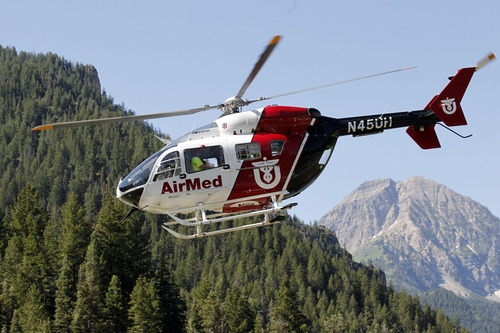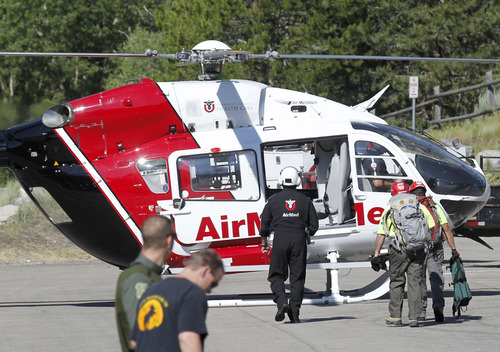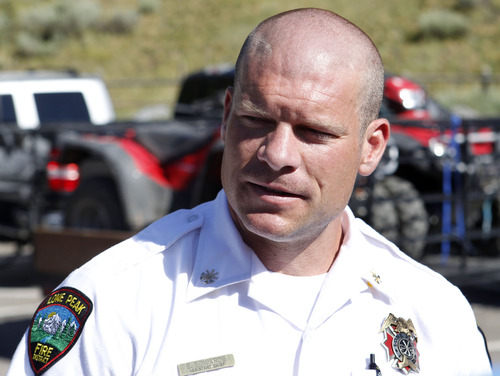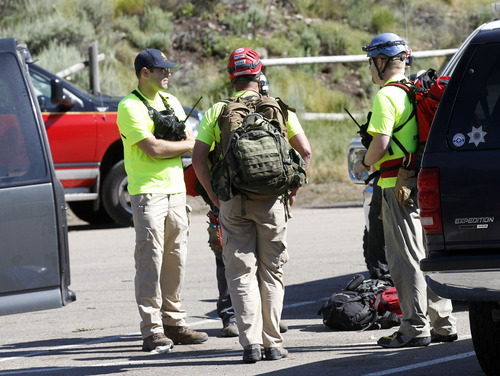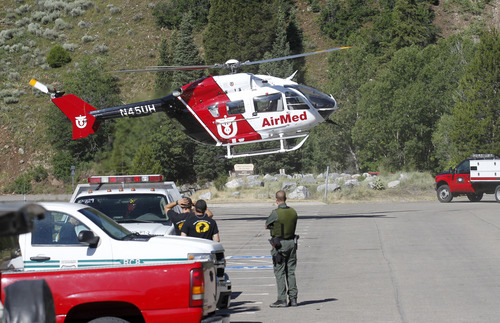This is an archived article that was published on sltrib.com in 2013, and information in the article may be outdated. It is provided only for personal research purposes and may not be reprinted.
Tibble Fork Reservoir, Utah County • One of two men who survived the crash of a helicopter Monday along a remote mountain peak in American Fork Canyon asked a paramedic treating him, "How did I survive this?"
Lone Peak Fire District paramedic Steve Allred said there could only be one response as emergency workers treated the man's multiple injuries: "You had somebody watching out for you, brother."
The improbable escape was an oft-repeated theme as rescue workers discussed the 8:22 a.m. crash along a rugged, rocky and, in places, heavily forested 9,880-foot area above Tibble Fork Reservoir. Twenty-eight-year-old pilot Gregory Walther of West Valley City and his student Terrance (Bud) Oakley, 24, of Sandy survived the crash, suffering bone fractures. They were in serious condition Monday, authorities said.
The Robinson R-22 aircraft — a single-engine, two-seat, two-blade light utility helicopter — crashed and then rolled downhill just inside the Utah County line adjacent to Salt Lake County. Somehow, the two men managed to stumble into a clearing about 50 yards away.
From there, Walther used a deactivated cellphone that only had one working number — 911 — to call for help. He said they were flying at a low level when a wind gust sucked the helicopter to the ground, causing it to crash and roll. Walther stayed in contact with dispatchers to help guide search and rescue ground crews and a helicopter looking for the wreckage and survivors.
Spencer Edwards, assistant chief of the Lone Peak Fire District, said there is little cell reception in the rural forested areas around American Fork Canyon, but somehow the men were lucky enough to crash in one of the few areas where cell phones worked. Otherwise, the men — who crashed in an area that typically sees only a few goat hunters each year, wouldn't have been easily located, rescuers said,.
"They drew a good hand this time," Allred said.
Utah County sheriff's Lt. Yvette Rice agreed: "Overall, this was a very positive outcome in a situation that could have been devastating … They literally came down just inches away from a granite rock face."
A state Department of Public Safety helicopter aided in the initial search, but it was a Utah County fixed-wing airplane that first spotted the wreckage, Rice said.
About 9:10 a.m., rescuers had hiked a half-mile uphill and reached the men, who were found sitting in the meadow, conscious and alert.
By early Monday afternoon, the men had been stabilized and flown to LDS and University hospitals in Salt Lake City. Walther suffered a compound fracture in his wrist and had back pain. Oakley had a head injury with pain in the rib cage and legs.
A five-member horseback team went up the mountain about the same time to recover wreckage and equipment at the request of the National Transportation and Safety Board, which will lead the crash investigation, Rice said.
Not only is the slope leading to the crash site heavily forested, but it also is strewn with large granite outcroppings and has become unstable due to recent rains, adding to rescuers' difficulties. The impact of the crash peeled open the front of the helicopter like a tin can, authorities said.
The Federal Aviation Administration's aircraft registry showed the helicopter belonged to the Tumbleweed Leasing Co., based in Salt Lake City.
Scott Benning, an assistant chief at Tumbleweed, confirmed that one of the company's pilots was conducting an instructional flight at the time of the crash.
Rice confirmed the two were participating in a training flight through the Upper Limit Aviation school.
Rice said the pilot was flying the helicopter at the time of the crash.
Tibble Fork is a small reservoir located north of Mount Timpanogos, about 7 miles up American Fork Canyon.
Twitter: @sltribjanelle
Twitter: @remims


